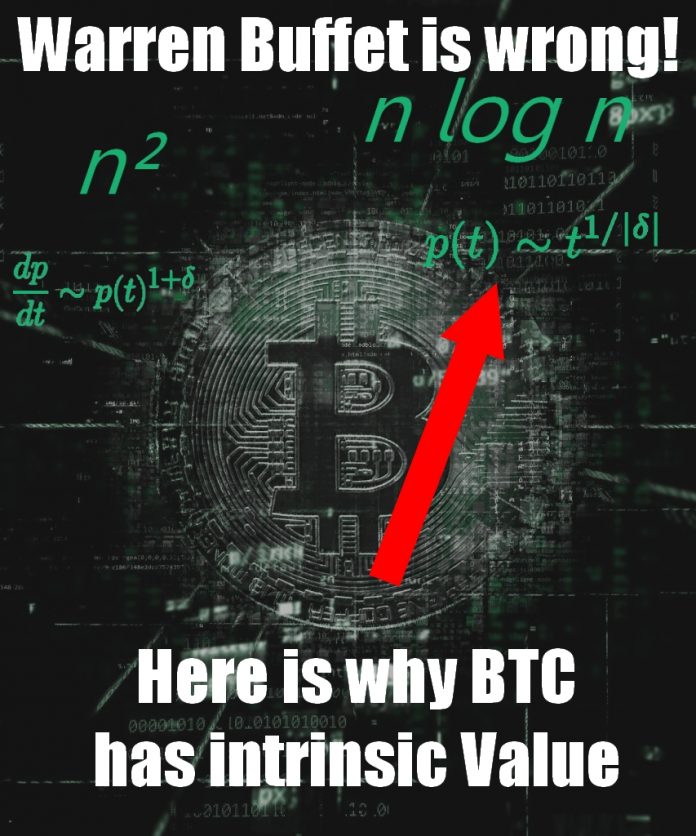Warren Buffet, Charlie Munger, and Bill Gates said in an interview with CNBC that Bitcoin has no intrinsic value.
Dan Larimer (blockchain-designer of Bitshares, Steem, and Eos) described Bitcoin as a company. It has developers, PR-agencies, cooperations, shares, users, and so on.
A company, even if it is based on a decentralized autonomous community (DAC) could be valued. But this does not mean that it has value.
Let’s see science-backed approaches.
Metcalfe’s Law
There is an intrinsic value for networks! Its the value people get from interacting on the network. If the interaction is transaction or communication doesn’t matter, it is both communication/interaction. With n users the network value grows as n² or better: n log n (Metcalfe’s network law). It is scientifically validated for:
- Facebook and Tencent: Zhang et al. 2015
*(Tencent is the Chinese pendant to FB)
- Bitcoin, Ethereum, Dash Alabi 2017
- Bitcoin: Peterson 2018, Civitarese 2018
This why the number of users is the most important parameter
These findings show that the number of users statistically represents the market value of the network. Because this is what those technologies are in the first place >>communication-networks<<.

The magic here is simple: if you have two nodes, your network is no network at all, the value is one connection. But add only three nodes more and it is already 10 connections. And with 12 nodes it explodes to 66 connections, hence the network has more value to its users. And value will be represented in price.
The critical mass for networks is of course higher. You have to pay the servers or running costs for the nodes. But once you reach the critical mass, the value you get from the network outplays the cost to run it by far.
Predict bubbles using Metcalfes Law
With linear growth of user base (or nodes), the value of the network grows roughly exponential!
But this is not the interesting part of the studies.
When we see the correlation between Metcalfe and the market cap or market value of a network, we could assume that it is possible to predict the future price. Unfortunately, this is not the case. It can only show if the price reflects the use of the network. Not more not less. But from another perspective, it could indicate the formation of bubbles!
what Bitcoin is used for?
First, we should be clear about the fact, what the purpose of the network-technology is. If it is only a transaction/communication network, then the fair price should reflect the use. When this is not the case, then there is speculation at work.
The Metcalfe-based value is the null hypothesis and the further the empirical value (price) diverges from the null hypothesis, the more confidence we have, that there is a bubble forming.
What is a bubble?
Well, I guess everybody can spot a bubble after the crash has happened. But What is a bubble? Bubbles are not only restricted to financial markets, they a universal phenomenon. Even the universe itself is a bubble. When a dynamical system matures exponentially towards a point of high instability, where a small external shock can cause an abrupt change of the properties of the system (phase transition), one speaks of a time finite singularity. (Sornette and Ide, 2001)
Those singularities result in tipping points, this is when a system crashes. There is a whole branch of math called catastrophe theory dealing with those events.
When a pregnant woman is in the 9th month, then the mother-child system matures towards a high instability and one movement can initiate the birth.
So it is not about the external events. It does not matter if it was the Chinese Newyear, the SEC, Korean regulators, Rothschild, the devil… Those reasons are secondary. The primary reason is that the system is ripe to fall. Like an apple. It does not matter if it is the wind, a bee or the wight of the apple, when it is ripe it will fall anyways.
How low will Bitcoin drop and when Bullrun?
With this in mind, you can even calculate where BTCs bottom could be. I always wondered why people are talking about bottoms. Physically there is no bottom out there. The bottom is always defined ex-post. It is defined by the trend reversal and a trend reversal is defined by the formation of a new trend. When a new trend forms, you know the reversal and when you know the reversal you know the bottom. So bottom-definition can only happen post factum.
As intelligent people, we are aware of reflexive structures in the market, so a called bottom can become a real one. A self-fulfilling prophecy. But what is it, that you have to analyze in order to spot some potentially self-fulfilling prophecy? The opinion of whom? This should depend on the voting mechanism. Is the price voted in a democratic fashion? Yes, kind of. Is it one person — one vote? No, ist more like “one dollar — one vote”. Right, and since money is Pareto-/unequally distributed (same with relevant information), the opinion of the majority can´t be that important. Or is it?
I don’t think that mainstream technical analysis helps, but this doesn’t mean that there are no trends to analyze.
Let´s first see when Lambo.
The basic assumption is, that there is not much institutional money in the market right now. The only money we have seen so far is from retail investors (like us). Then there is money from VC-Funds (they are not bigger as 100 Million, some few maybe 1 Billion but not fully invested) and there is money from some Wallstreet players.
So one could assume that price movements are gossip dependent. And well, this is exactly what studies showed:
(Lui und Tsyvinki 2018): Risks and Returns of Cryptocurrency
(Phillips and Gorse 2018): Cryptocurrency price drivers: Wavelet coherence analysis revisited
(ElBahrawi et al. 2017): Evolutionary dynamics of the cryptocurrency market
(Wang and Vernge 2017): Buzz Factor or Innovation Potential: What Explains Cryptocurrencies’ Returns?
(Kim et al. 2016): Predicting Fluctuations in Cryptocurrency Transactions Based on User Comments and Replies
(Kristoufek 2015): What Are the Main Drivers of the Bitcoin Price? Evidence from Wavelet Coherence Analysis
(Garcia et al. 2014): The digital traces of bubbles: feedback cycles between socio-economic signals in the Bitcoin economy
(Matta et al. 2015): Bitcoin Spread Prediction Using Social And Web
Search Media
(Garcia und Schweizer 2015): Social signals and algorithmic trading of Bitcoin
(related Studies)
So this body of evidence indicates that price-movements (as long as there is no change in the set of players) are predictable by social media and Google Trend search!

Right now (at least on Google) it does not look like Bitcoin becomes popular again. So how low can it go based on network-models like Metcalfe?
In March 2018 Sornette et al. made an ex-ante prediction and calculated with Metcalfe and the Log-Periodic Power Law Singularity model (LPPLS) that at the end of the year 2018 Bitcoin if the dynamics are comparable to the crash of 2015, should be at 77-64 Billion market cap. And the model was exactly right.
And you know what? Compared to the actual use of the network, Bitcoin is still overvalued. A fair price level should be way lower ($ 44–22 Billion). The predictions are heavily dependent on the accurate number of active users (which is not that easy to detect).
I would criticize that the actual use of the technology is not p2p-payment but more store-of-value so that the model should be adjusted. One should not forget, that it does not show the future. If there is a catalysator like an ETF-approval then the market dynamics will change.









